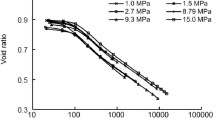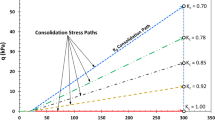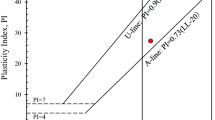Abstract
Soils subjected to the loading or unloading in geotechnical engineering applications like foundation excavation, embankment, and tunnel construction will reconsolidate under different stress paths. This paper presents an experimental investigation on the effect of stress path on shear strength characteristic of reconstituted Zhenjiang clay. Specimens were isotropically or anisotropically consolidated and sheared without drainage in triaxial shear tests. Test results showed that undrained shear strength (Su) under various stress paths is markedly influenced by the stress ratio (η), which is defined as the ratio of the deviator stress to the mean effective stress (p′). Su almost linearly increases with p′ or η at a given η or p′. The value of Su for specimens consolidated under different stress paths can be predicted as a function of p′ and η, i.e., Su = (0.13η + 0.37)p′. It is concluded that Su of specimen under anisotropic consolidation is higher than that under isotropic consolidation at a certain p′. Moreover, specimen anisotropically consolidated to the same p′ at higher η results in an increase in Su compared with that at lower η. Duncan-Chang model can be employed to characterize the strength behavior of reconstituted clays under various consolidation stress paths. The variation of c or c′ is insignificant under different η, indicating that the effect of η on cohesion is negligible. φ increases linearly with η while φ′ shows an insignificant change.










Similar content being viewed by others
Abbreviations
- c :
-
Total cohesion
- c′:
-
Effective cohesion
- E i :
-
Initial modulus
- ε a :
-
Aial strain
- φ :
-
Total internal friction angle
- φ′:
-
Effective internal friction angle
- G s :
-
Specific gravity
- η :
-
Stress ratio (=q/p′)
- K 0 :
-
Coefficient of earth pressure at rest
- K :
-
Modulus number
- LL:
-
Liquid limit
- n :
-
Modulus exponent
- \( {\sigma}_1^{\prime } \) :
-
Major effective principal stress
- \( {\sigma}_3^{\prime } \) :
-
Minor effective principal stress
- PL:
-
Plastic limit
- p′:
-
Mean effective stress [=(\( {\sigma}_1^{\prime } \)+2\( {\sigma}_3^{\prime } \))/3]
- q :
-
Deviator stress (=\( {\sigma}_1^{\prime }-{\sigma}_3^{\prime } \))
- R f :
-
Failure ratio
- S u :
-
undrained shear strength
- w 0 :
-
Initial water content
References
ASTM D2216 (2010) Standard test methods for laboratory determination of water (moisture) content of soil and rock by mass. ASTM D2216-10, West Conshohocken
ASTM D4318 (2010) Standard test methods for liquid limit, plastic limit, and plasticity index of soils. ASTM 4318-10e1, West Conshohocken
ASTM-D2487 (2017) Standard practice for classification of soils for engineering purposes (Unified Soil Classification System). ASTMD2487-17, West Conshohocken
ASTM-D4767 (2011) Standard test method for consolidated undrained triaxial compression test for cohesive soils. ASTM International, West Conshohocken
ASTM-D854 (2014) Standard test methods for specific gravity of soil solids by water pycnometer. ASTM D854-14, West Conshohocken
Bozzano F, Bretschneider A, Martino S, Prestininzi A (2014) Time variations of the K0 coefficient in overconsolidated clays due to morphological evolution of slopes. Eng Geol 169:69–79. https://doi.org/10.1016/j.enggeo.2013.11.013
Brosse A, Jardine RJ, Nishimura S (2016) Undrained stiffness anisotropy from hollow cylinder experiments on four Eocene-to-Jurassic UK stiff clays. Can Geotech J 54(3):313–332. https://doi.org/10.1139/cgj-2015-0320
Cai Y, Hao B, Gu C, Wang J, Pan L (2018) Effect of anisotropic consolidation stress paths on the undrained shear behavior of reconstituted Wenzhou clay. Eng Geol 242:23–33. https://doi.org/10.1016/j.enggeo.2018.05.016
Chang CY, Duncan JM (1970) Analysis of soil movement around a deep excavation. J Soil Mech Found Div 96(5):1655–1681
Chen E, Yan M, Ding J, Gao C, Gan Y (2019) Effects of moisture content and plasticity index on duncan-chang model parameters of hydraulic fill soft soil. World J Eng Technol 7(3):408–417. https://doi.org/10.4236/wjet.2019.73030
He Y, Chen X (2014) The application of improved Duncan-Chang model in unloading soil. Open Civil Eng J 8:410–415. https://doi.org/10.2174/1874149501408010410
Hong ZS, Bian X, Cui YJ, Gao YF, Zeng LL (2013) Effect of initial water content on undrained shear behaviour of reconstituted clays. Géotechnique 63(6):441–450. https://doi.org/10.1680/geot.11.p.114
Keyhani R, Haeri SM (2013) Evaluation of the effect of anisotropic consolidation and principle stress rotation on undrained behavior of silty sands. Sci Iran 20(6):1637–1653
Li X, Cao W, Zhou Z, Zou Y (2014) Influence of stress path on excavation unloading response. Tunn Undergr Space Technol 42:237–246. https://doi.org/10.1016/j.tust.2014.03.002
Malandraki V, Toll DG (2001) Triaxial tests on weakly bonded soil with changes in stress path. J Geotech Geoenviron 127(3):282–291. https://doi.org/10.1061/(asce)1090-0241(2001)127:3(282)
Mayne PW (1985) Stress anisotropy effects on clay strength. J Geotech Eng 111(3):356–366. https://doi.org/10.1061/(asce)0733-9410(1985)111:3(356)
Ng CWW, Fung WT, Cheuk CY, Zhang L (2004) Influence of Stress ratio and stress path on behavior of loose decomposed granite. J Geotech Geoenviron 130(1):36–44. https://doi.org/10.1061/(asce)1090-0241(2004)130:1(36)
Nishie S, Wang L, & Seko I (2007). Undrained shear behaviors of high plastic normally K0-consolidated marine clays. Solid Mech Its Appl 273–286. doi:https://doi.org/10.1007/978-1-4020-6146-2_12.
Nishimura S, Minh NA, Jardine RJ (2007) Shear strength anisotropy of natural London Clay. Géotechnique 57(1):49–62. https://doi.org/10.1680/geot.2007.57.1.49
Shi J, Qian S, Zeng LL, Bian X (2015) Influence of anisotropic consolidation stress paths on compression behaviour of reconstituted Wenzhou clay. Géotechnique Lett 5(4):275–280. https://doi.org/10.1680/jgele.15.00113
Toyota H, Susami A, Takada S (2014) Anisotropy of undrained shear strength induced by K0 consolidation and swelling in cohesive soils. Int J Geomechanics 14(4):04014019. https://doi.org/10.1061/(asce)gm.1943-5622.0000344
Toyota H, Takada S, Susami A (2018) Mechanical properties of saturated and unsaturated cohesive soils with stress-induced anisotropy. Géotechnique 68(10):883–892. https://doi.org/10.1680/jgeot.17.p.018
Wang L, Shen K, Ye S (2008) Undrained shear strength of K0 consolidated soft soils. Int J Geomech 8(2):105–113. https://doi.org/10.1061/(ASCE)1532-3641(2008)8:2(105)
Wang J, Feng D, Guo L, Fu H, Cai Y, Wu T, Shi L (2019) Anisotropic and noncoaxial behavior of K0-consolidated soft clays under stress paths with principal stress rotation. J Geotech Geoenviron 145(9):04019036
**ong JH, Kou XY, Liu F, Jiang MJ (2011) Applicability of Duncan-Chang model and its modified versions to methane hydrate-bearing sands. Adv Mater Res 347-353:3384–3387. https://doi.org/10.4028/www.scientific.net/amr.347-353.3384
Yu C, Xu Q, Yin Z (2013) Softening response under undrained compression following anisotropic consolidation. J Cent South Univ 20(6):1703–1712. https://doi.org/10.1007/s11771-013-1663-z
Zeng LL, Chen XP (2009) Analysis of mechanical characteristics of soft soil under different stress paths. Rock Soil Mech 30(5):1264–1270 (in Chinese)
Zhang B (2011) Analysis on parameters in Duncan-Chang constitutive model. Adv Mater Res 368-373:2900–2903. https://doi.org/10.4028/www.scientific.net/amr.368-373.2900
Zhen YR, Shen ZJ, & Gong XN, 2002 Principle of geotechnical plastic mechanics: generalized plastic mechanics. China Architecture & Building Press. (in Chinese)
Funding
We gratefully appreciate the financial supports from the National Natural Science Foundation of China (No. 51978315 and No. 41402251). The first author also acknowledges the support from China Scholarship Council (No. 201908320213) for visiting the University of Wisconsin-Madison as a Research Scholar.
Author information
Authors and Affiliations
Corresponding author
Additional information
Responsible Editor: Zeynal Abiddin Erguler
Rights and permissions
About this article
Cite this article
Yin, J., Zhao, Al., Han, Wx. et al. Experimental investigation on strength behavior of reconstituted Zhenjiang clay under different consolidation stress paths. Arab J Geosci 14, 109 (2021). https://doi.org/10.1007/s12517-020-06424-1
Received:
Accepted:
Published:
DOI: https://doi.org/10.1007/s12517-020-06424-1




